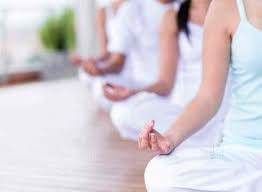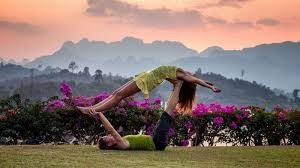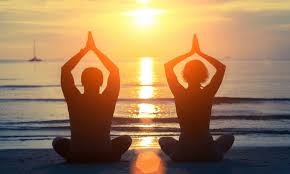
The esoteric contextual meaning of the word Tantra has changed over time when used in different yogic texts. Originally Tantra was used to mean “weave or loom,” and later was used to define “technique, device, or method.” A more current and relevent definition comes from the Kāmikā-tantra text:
Because it elaborates (tan) copious and profound matters, especially relating to the principles of reality (tattva) and sacred mantras, and because it provides liberation (tra), it is called a tantra.
Tantra Yoga- The combination of Raj Yoga, Gyan Yoga, Bhakti Yoga, Karma yoga:
Tantra means “To weave or expand”. The idea with Tantra yoga, then, is to weave together many yoga practices, and other spiritual styles and teachings, in order to connect with others and the universe. When practiced consistently, Tantra Yoga can help you get in tune with who you are, achieve your goals, and, when done with a partner, deepen your relationship.
Tantra yoga takes the whole body and whole person into account and works with five different bodies:
The physical body
The energetic body
The mental/emotional body
The wisdom body (the inner teacher)
The bliss body
Each of these bodies has its own weaknesses and its own strengths—all of which are usually buried deep down. When we can bring them all to the surface, we can stop responding unconsciously and gain control over our desires. Through Tantra yoga, one is said to be able to ultimately reach a state of eternal bliss. As a practice, Tantra yoga is rooted in the traditional Hatha yoga and weaves together numerous other styles including Kundalini, Bhakti, Karma, Raja and more. But Tantra yoga is also about more than just the asanas and yogic traditions.
Resting on the mat. (If knees are sensitive, you can place the folded edges of a blanket behind your knees before folding forward or rest your seat and perhaps forehead on yoga blocks.) If shoulders allow, bring your palms to touch in prayer, symbolic of union with all aspects of yourself. Defining the tantras The word tantra is a combination of two processes, ‘tanoti’ and ‘trayati’, meaning expansion and liberation. The root ‘tan’ stands for the word tanoti and the root ‘tra’ stands for the word trayati. The word tanoti means to stretch, to extend, to elaborate, to expand. The word trayati means to liberate, to free, to separate. So it is clear that tantra is a process of expansion and finally absolute freedom in the highest existence.
Many of the tantras are purely vedic in origin. You can conveniently put them into two progressive categories of shruti (revealed scriptures) and smriti (transmitted by memory). Tantras that have their existence in shruti and follow the vedic tradition implicitly are shrauta tantras. Those tantras having all respect for shruti but which adjust with the ever-shifting social concepts are known as smarta tantras. The shrauta tantras, that is to say the vedic tantras, were replete with an absolute sense of purity and orthodoxy. As a result, there developed a tradition of moral restraints such as ahimsa or non-violence and the like. However, those who were used to performing animal sacrifices and other such older customs did not agree with orthodox purity or ahimsa. Thus the vedic tantras were naturally divided in the course of time into two groups: one followed the path of ahimsa, the other followed the tradition of animal sacrifices, drinking wine and the like. However, in those days they did not use the word tantra; they used the word yajna. Later, these natural divisions of vedic tantra developed into two main orthodox currents, namely shakta tantra, worshipping Shakti, and shaiva tantra, worshipping Shiva.
Tantra explains (Tanoti) in great detail the knowledge concerning Tattva (Truth or Brahman) and Mantra (mystic syllables). It saves (Trayate). Hence it is called Tantra. The Tantras are not books of sorcery, witchcraft, magic spells, and mysterious formulae. They are wonderful scriptures. All persons without the distinctions of caste, creed, or colour may draw inspiration from them and attain spiritual strength, wisdom, and eternal bliss. Mahanirvana and Kularnava Tantras are the important books in Tantra Sastra. Yoga Kundalini Upanishad of Krishna Yajurveda, Jabala Darsana, Trisikha Brahmana, and Varaha Upanishad are useful for getting knowledge of Kundalini Sakti and the methods to awaken it and take it to Sahasrara Chakra at the crown of the head. The Tantra is, in some of its aspects, a secret doctrine. It is a Gupta Vidya. You cannot learn it from the study of books. You will have to get the knowledge and practice from the practical Tantrikas, the Tantric Acharyas and Gurus who hold the key to it. The Tantric student must be endowed with purity, faith, devotion, dedication to Guru, dispassion, humility, courage, cosmic love, truthfulness, non-covetousness, and contentment. Absence of these qualities in the practitioner means a gross abuse of Saktism. The Sakti Tantra is Advaita Vada. It proclaims that Paramatman (Supreme Soul) and Jivatman (individual soul) are one. The Saktas accept the Vedas as the basic scriptures. They recognise the Sakta-Tantras as texts expounding the means to attain the goal set forth in the Vedas.
Tantra Yoga lays special emphasis on the development of the powers latent in the six Chakras, from Muladhara to Ajna. Kundalini Yoga actually belongs to Tantric Sadhana which gives a detailed description about this serpent-power and the Chakras (plexus). Entire Tantric Sadhana aims at awakening Kundalini, and making her to unite with Lord Sadasiva, in the Sahasrara Chakra. Methods adopted to achieve this end in Tantric Sadhana are Japa of the Name of the Mother, prayer, and various rituals.

Tantra yoga was introduced to the west in the nineteenth century as exotic sensual-spiritual practices to deepen connection and intimacy. The interest in Eastern spirituality and the sensual and revolutions of the late 1960s and early 1970s further popularized and cemented Tantra as a yoga technique for great Sensuality. Tantra as a sacred sacral chakra practice does relate to classical tantric teachings on the subtle energy body and an embodied presence to sacral chakra union.
But to simplify and conflate sacral chakra techniques and interpersonal intimacy with the practice of tantra yoga is a distortion of this elaborate and complicated system of enlightenment.


Today many tantric and tantricas jointly do their workshop and events and even tantra festival worldwide. So how they conduct workshops in the world and how they prepare the next generation for giving them a new era tantra lifestyle in this modern time. The answer is so simple. It is nothing but a good and pure heart connection as tantra mention it in the ancient tantra temple and text. I live in India. I am aware of tantra from my childhood. Later I grown up in the spiritual environment where I learnt many spiritual practices in my life though I am only 31 years old. To me, tantra is such an authentic spiritual prescription and healing therapy where anyone can indulge deeply without thinking too much. Tantra is so beneficial as it gives light.
To the people who are going through the dark world even not knowing themselves better. Tantra is a hope who lost their intimacy, who lost their vigour, who lost their confidence, who are bored in the monotonous life today. Human body is a great spiritual temple where mind and spirit existed each other by collaborating their own methodologies. This is a very mystic at all and a vital point of no return to the darkness, gloominess. It is a great learning platform where ancient Indian and Tibetan tantra rituals can be learn. Not only the erotic but also educational and spirituality mingling with the tantra massage Workshop
Purification of the space, body, mind and aura using various items, meditation, prayers, consecration and spiritual magic
Tantric Yoni Mudra: A special and intimate ritual for couples involving sensual activation of the chakras as a tool for reaching higher states of mind no Naked Transfiguration Ritual to unravel the pure energy of Shiva and Shakti
Body Mudras Ritual Vol. 1: Using the tantric knowledge of nature’s elements in conjunction with astrological factors to bring about a shift in consciousness
Body Mudras Ritual Vol. 2: Raising the awareness to the next level with the pure naked body where both Shiva’s and Shakti’s use transfiguration and the third eye to summon the Divine with the assistance of sacred mudras and other factors
Fire Ritual: For clearing the mind from blockages and impurities, eliminating past negative karma and cleansing the aura and clothing free body deeply
Sublimation Ritual: Using the secret Indian Somas to open the higher chakras, achieve a higher state of mind and spirit while rejuvenating the physical body. This ritual includes a unique meditation for communing with the Divine and elevating your level of consciousness.
And more: This retreat will also include various lectures, meditations, daily Tantra Yoga sessions, satsangs and a surprise midnight rituals..
Tantric yoga and tantric Sensuality are from two different branches of tantra.
Traditional tantra is divided into red tantra and white tantra. White tantra is the solo practice, which incorporate yoga and meditation. Red tantra is the sacral chakra practice.
While both use sacral chakra energy, the goal of the two practices is different. The goal of red tantra is to create a deeper bond with a partner, while white tantra is about creating a deeper bond with yourself.
While the Western practice of tantra might suggest otherwise, you actually can’t have red tantra without white tantra..
“Red tantra is your opportunity to bring everything you’ve learned in your solo practice into an exchange with a lover,”
Two words: spiritual liberation.
“This isn’t about toning the body or getting a workout” . “Tantric yoga is about being purposeful with your breath, embodiment, and making love with your own body.”
Experts say a regular tantric practice can help you reap the following benefits:
Reduced stress, anxiety, or depression.
Better understanding of and love for oneself
Improved sleep quality.
Boosted confidence and performance in the bedroom.
Improved quality of life.
Increased capacity for intimacy.
“You can absolutely do it alone”.
Because the practice requires a very subtle level of awareness, it can be challenging to self-guide. Some experts recommend waiting to practice alone until you understand the principles.
“It’s a fun date idea to do your solo tantra practice in the same room as someone else” . “It’s like fine- tuning your instruments in the same room so you can make music together later.” Hot!
“If you create a deep inward focus in your home yoga practice — whatever that entails — and feel that your movement is a sacred doorway to direct experience of the Divine, that can qualify as tantric yoga”.
If, however, you want to do a deep dive into classical tantra yoga, “you’ll want to work one-on-one with a tantra guru.”
To find out if the tantric class is legit, ask:
1. Are your classes solo or partnered? (Classical tantra yoga should be solo.)
2. Are you teaching red or white tantra? (The answer should be white tantra.)
3. What is the goal of the class? (The answer should suggest self-growth and self-awareness.)
4. Does the class include chanting? (The answer should be yes.)
5. What is the teacher’s training? (The teacher should be trained in Hatha yoga, Integral yoga, Kundalini yoga, and tantra.)
